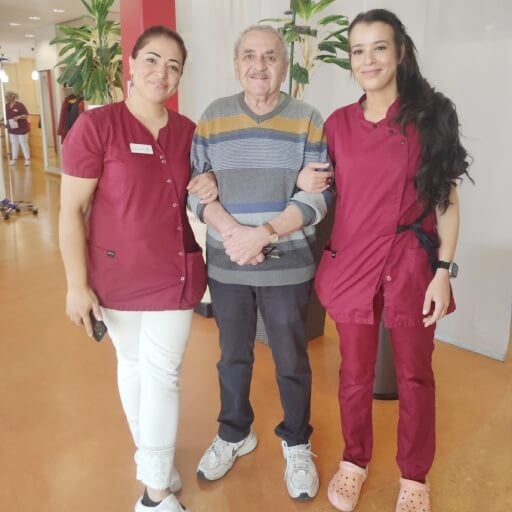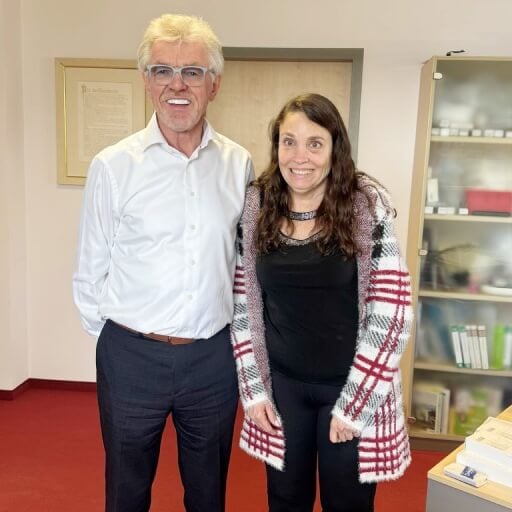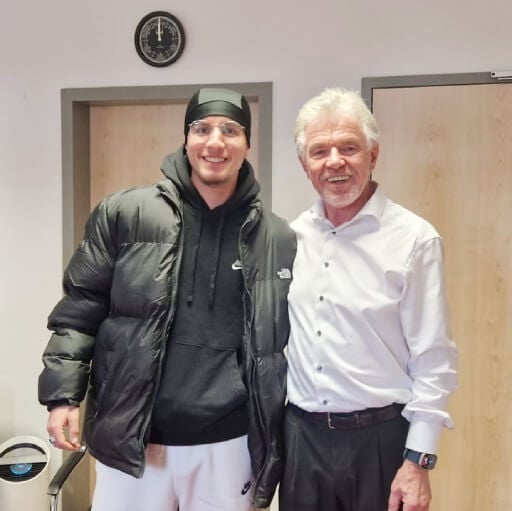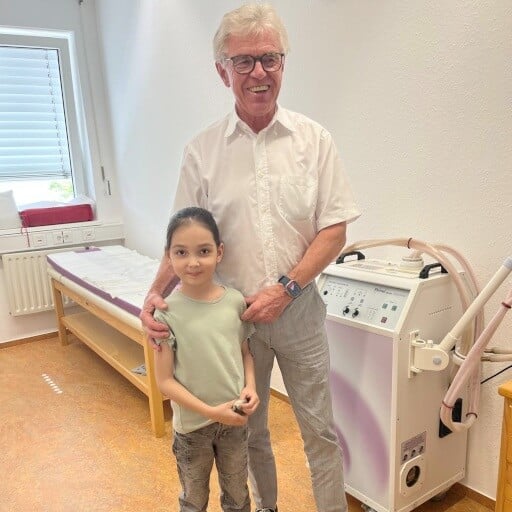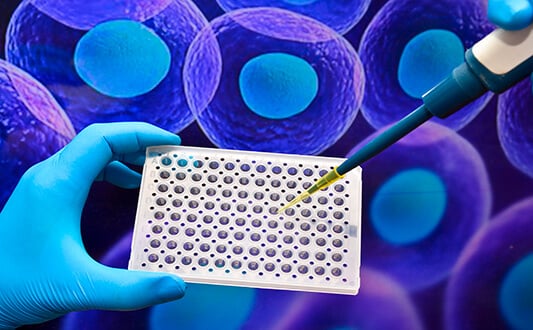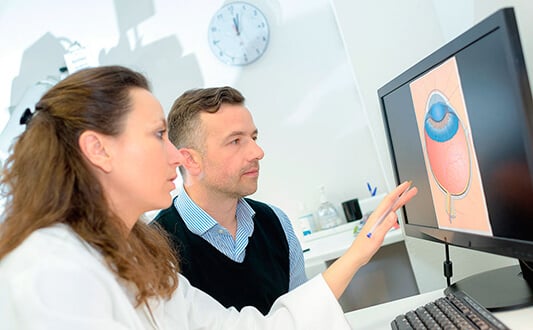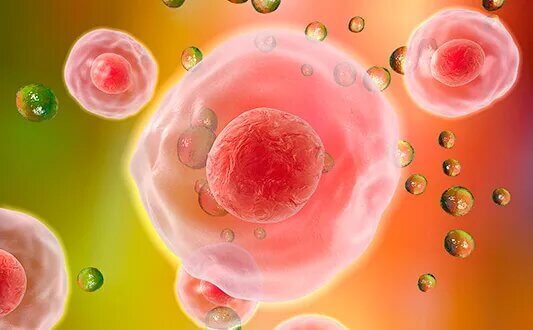Visual information undergoes complex processing before it can turn into a clear picture. The optic nerve is largely responsible for this process. Unfortunately, it can atrophy due to various pathological processes. Currently, there are no treatments in medicine that would completely cure degenerative diseases of the optic nerve. Stem cell therapy offers a new modern approach, the goal of which is to partially or completely restore neurological functions.
The Pathogenetic Mechanism of Optic Atrophy
The optic nerve originates from the retina and conducts video signals between the retina and the cerebral cortex. A damaged optic nerve becomes unable to transmit signals to the brain.
Optic nerve diseases, including optic neuropathy (optic nerve atrophy), are chronic and degenerative pathologies of the optic analyzer that inevitably lead to vision loss. Most diseases of the optic nerve are caused by apoptosis (programmed death) of retinal nerve cells or other nearby nerve structures.
Such pathologies have complex pathophysiological mechanisms of occurrence. The reasons for their occurrence can be different:
- Ophthalmic diseases – glaucoma (increased intraocular pressure), myopia, retinitis pigmentosa, eye infections, pathological processes, and retinal trauma, inflammation of the optic nerve (neuritis), and other eye diseases.
- Injuries – craniocerebral trauma, trauma to the structures of the eye.
- Neoplasms in the orbital cavity – meningioma, osteosarcoma, optic nerve glioma, and orbital malignant tumors.
- Central nervous system pathologies – arachnoiditis (inflammation of the meninges), brain cancer, pituitary tumors, multiple sclerosis, brain abscesses, and meningitis.
- Vascular pathologies – aneurysms, atherosclerotic changes in the optic nerve, blockage of the central artery by a thrombus, increased intracranial pressure due to arterial hypertension, and retinopathies of various etiology.
- Genetic disorders are specific DNA mutations that can be either acquired or congenital.
- Intoxication of the body – poisoning due to the intake of surrogate alcoholic beverages (methyl alcohol), narcotics, nicotine, and exposure to hazardous chemicals.
- Infections – viral, bacterial, or fungal diseases, including influenza.
Atrophy of the optic nerves (ONA) is characterized by impaired blood flow in the smallest capillaries, a decrease in the size, and death of nerve fibers. Disruption of blood flow in the vessels supplying the nerve structures leads to oxygen deficiency (hypoxia) and adverse metabolic changes within the cells. In turn, the information perceived by the retina reaches the brain in a distorted form. The development of atrophy occurs gradually. In 21% of cases, the disease causes irreversible blindness and in 68% of cases, it leads to disability.
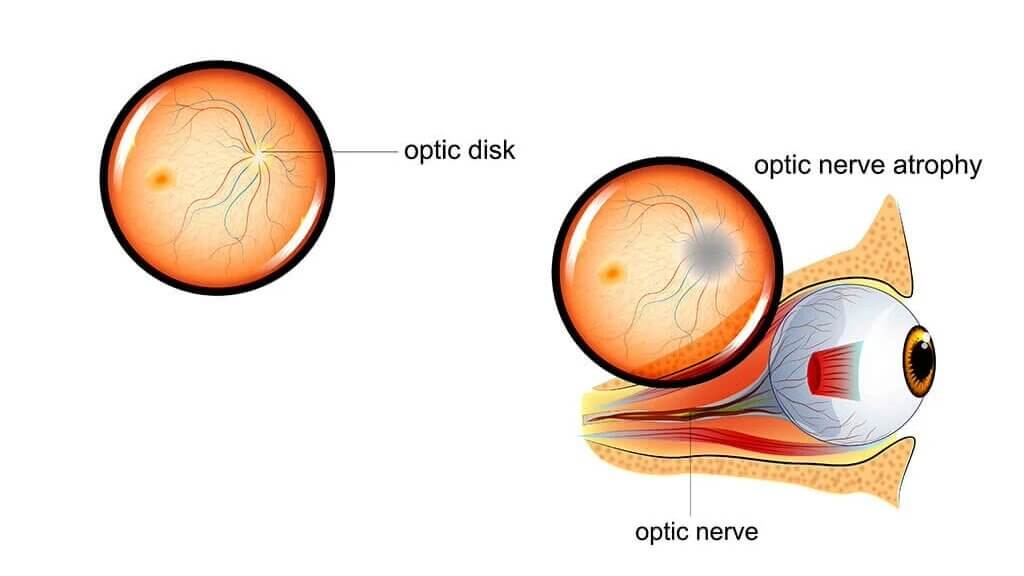
Types of Optic Atrophy
Optic atrophy has many classifications that are necessary for a more accurate diagnosis.
Depending on the clinical picture, the following classifications are distinguished:
- Primary (simple) atrophy develops as an independent disease. In this case, the optic nerve head has clear boundaries, albeit pale. This type is often characterized by the vasoconstriction of the retina.
- Secondary atrophy occurs due to a concomitant disease leading to dysfunction of the optic nerve. The boundaries of the optic nerve head become blurred.
- Glaucomatous atrophy occurs with glaucoma and is accompanied by increased intraocular pressure.
Depending on the location:
- Descending – when the optic nerve fibers are affected.
- Ascending – when the retinal cells are affected.
Depending on the progression of the pathological process:
- Stable type – damage to the nerve reaches a certain degree and remains stable for a long time.
- Progressive type – the pathological process is constantly progressing and is accompanied by a rapid loss of vision.
Depending on the extent of the lesion:
- Partial (initial) atrophy – only a small area of the nerve is affected. Pathology is manifested by severe loss of vision, which cannot be corrected with optical instruments (glasses and contact lenses).
- Complete atrophy – damage to the entire nerve, when a person completely loses the ability to see.
Depending on the severity:
- One-sided – when one eye is affected.
- Bilateral – when both eyes are affected.
The disease can also be congenital and manifest in childhood, or it can be acquired and manifest at any age.
What is Stem Cell Therapy for ONA?
Cell therapy is a promising, modern, and rapidly developing area of medicine. It allows doctors to achieve good results in the treatment of various diseases of the nervous system. The main results of cell therapy are achieved by replacing dead neurons (nerve cells), improving tissue tropism, forming new nerve endings and blood vessels, and improving the function of the immune system.
Cell therapy involves treatment with stem cells. These are special types of cells that have the ability to specialize in any cells of the human body. Some techniques are still in clinical trials. Other therapeutic approaches have already been successfully applied in many clinics around the world, including in Germany.
The benefits of cell therapy:
- Formation of new blood vessels.
- Increased circulation in the vessels of the optic nerve and the retina.
- Improved supply of nerve fibers.
- Ability to repair tissue structures of the visual analyzer.
- Secretion of biologically active compounds, thereby preventing scarring.
- Increase of immunity and suppression of the undesirable activity of the immune system in the pathological focus.
- Resumption of normal tissue metabolism.
- Good tolerability.
A stem cell treatment for the eyes has practically no contraindications and can be performed on patients of any age with various types of atrophy.
Stem Cell Therapy for Optic Atrophy Repair in Germany
Stem cell therapy is widely studied as a treatment of degenerative eye diseases, it aims at replacing dead neurons and restoring nerve circuits. One of the clinical trials in Switzerland demonstrated the high effectiveness of stem cells in nerve damage. Clinical trials were also carried out at leading medical centers in Germany, Switzerland, and Belgium.
A good therapeutic effect was observed in 70-90% of cases in the form of improved motor and sensory functions. Cell therapy has shown the best results in lesions of brain nerves, degenerative pathologies, infections of the nervous system and pathologies of a hypoxic nature.
Recent data has shown that stem cell trophic factors protect damaged neurons from death and stimulate the formation of new interneuronal connections. Moreover, cell therapy significantly slows down further vision loss in advanced patients. Stem cell therapy, in combination with specialized therapies, helps to manage the main symptoms of optic nerve atrophy (loss of central, peripheral and color vision) and promotes tissue regeneration.
Types of Stem Cells and Their Use in ONA
There are three groups of stem cells, which differ depending on their location in the body and their activity (the ability to develop in different cell lines). Ophthalmology conducts research on all these groups.
- Embryonic stem cells (ESCs) are cells located in the inner cell mass of an embryo at an early stage of its development. ESCs are pluripotent, which means that they can become any cells during development. They do not produce specific antigens, these can be a common cause of incompatibility between donor tissues and recipients during transplantation. ESCs can be effective in the treatment of degenerative diseases of the retina, pathologies of retinal pigment epithelium and optical neuropathies. In many countries, ESC research is prohibited at the legislative level, since the extraction of them from the embryo interrupts its further development.
- Fetal stem cells – this group of cells is extracted from the fetus after an abortion or from cord umbilical blood. Fetal SCs are pluripotent and more functional than adult SCs. Such cells show the rate of photoreceptor recovery and are capable of prolonged doubling during cultivation. However, their use also poses ethical concerns. In many countries of the world, fetal cell research is prohibited by law.
- Adult stem cells are immobile and are non-specialized cells located in mature tissues. Adult SCs perform the function of replacing dead cells with new ones and promoting tissue regeneration. They create a microenvironment for tissues, protect them from degeneration (destruction) and also have the ability to self-renew and form mature cells. Different types of SCs can differentiate into hematopoietic stem cells, mesenchymal stem cells and neural stem cells.
For many years, scientists believed that only specialized structures could be obtained from stem cells but, as it turned out, mature cells extracted from the body of an adult can also be reprogrammed.
Mesenchymal Stem Cells in Optical Neuropathies
Mesenchymal stem cells (MSCs) are multipotent and self-renewing stem cells capable of rapid division. Among the various types of stem cells, mesenchymal cells are the most suitable for transplantation in the case of optic neuropathies, since they have strong immunomodulatory, neuroprotective and regenerative properties. In addition, mesenchymal stem cells do not have markers of the major histocompatibility complex on their surface, which is a complex of antigens associated with transplant rejection. In addition, they do not contain oncogenic factors. MSCs produce several growth factors that can create a substitution effect, activate the body's internal repair mechanisms, and promote the survival of healthy cells.
The stem and immune properties of mesenchymal cells are more comparable to those of embryonic cells than of other adult cells. Due to their ability to supply the optic nerve with new neurons and glial cells, MSCs play an important role in the treatment of diseases of the optic nerve and retina. With atrophy of the optic nerve, an improvement in vision was observed, and after cell therapy there were no side reactions such as an inflammatory or infectious process. Mesenchymal stem cells are an excellent alternative to embryonic stem cells, and there are no ethical concerns about retrieving them.
Sources of Mesenchymal Stem Cells
Bone marrow is the first source of mesenchymal stem cells, followed by umbilical cord blood and adipose tissue. Bone marrow is the best source of MSC, but in some cases it has contraindications such as limited growth rate, donor age, and some hereditary risks of tissue sampling.
With regard to the extraction of MSCs from umbilical cord blood, a special protocol is required, and it is not always possible to follow it. Also, it is not always possible to find a source of cord blood. Mesenchymal cells extracted from adipose tissue have a similar structure and phenotype to bone marrow cells. These cells reproduce better and are easier to obtain with liposuction procedures.
How is Stem Cell Therapy for ONA Carried Out in Germany?
Stem cell drugs contain millions of viable neural progenitor cells that make up the optic nerve.
Stem cell treatment for optic nerve atrophy includes several stages:
- The specialists extract stem cells from the bone marrow by puncture of the ilium or from adipose tissue, similar to liposuction.
- The main characteristics of stem cells are assessed, such as the number and viability, as well as the presence of any blood infections.
- If the cellular material meets all the requirements for reimplantation, it is purified. Stem cells' viability should reach 98-99%.
- The required amount of the drug is injected into the subtenon and suprachoroidal spaces of the eye (i.e. in certain areas of the orbit near the optic nerve). This operation is less traumatic and takes little time.
- To consolidate the results of treatment, it is possible to conduct a second session in 1-2 months.
This method of administration ensures the delivery of the drug directly to the pathological focus, which guarantees the most pronounced effect from the procedure. The treatment is easily tolerated by patients and has no side effects. To achieve the best results, an additional course of reflexology and electrical stimulation is prescribed. If necessary, drug therapy is also carried out.
What Happens After the Stem Cell Therapy for ONA?
After the injection, the stem cells form a population of target cells that constantly multiply, restore the conduction of nerve impulses and are able to provide the visual analyzer with new nerve cells for 1-1.5 years.
The stem cells’ resources are targeted at restoring damaged tissues. At this stage, the patient may feel discomfort and an exacerbation of the underlying disease will occur. This will soon decrease in presence, and after 2 weeks the discomfort will disappear.
A month later, the phase of the regeneration of the missing nerve fibers and neurons begins. This phase lasts 6 months. The patient's condition improves rapidly depending on the clinical course of optic nerve atrophy, the patient's age, individual characteristics and the presence of concomitant pathologies.
Stem Cell Therapy for ONA Results
Clinical trials of the use of stem cells for optic neuropathy have been carried out in Germany, China and other developed countries since 2008. Patient improvement was assessed using visual, function-related, quality-of-life tests. According to statistics, positive results appear approximately 3 months after the start of therapy and remain stable for 12 months. This is best seen in specific examples.
Yuri, 58 years old
At the age of 54, the patient underwent a removal of a benign brain tumour, which caused the onset of descending optic atrophy in both eyes. After the injection of his own stem cells, his vision improved by 15%. This was followed by a second session to consolidate the results, thanks to which, he began to distinguish colours.
Valeria, 24 years old
The patient had bilateral optic atrophy and visual loss of up to 20%. The combination of drug therapy with physiotherapy methods, did not give positive results. After the first cell therapy procedure, her vision began to gradually improve: with her left eye she could see from a distance of 1 metre, with her right eye, from a distance of 1.03 metres. During the first week after the procedure, Valeria began to distinguish shades of red and could see large objects from a great distance. During the second week, she could see with her right eye from a distance of 2.85 metres and with her left eye from a distance of 1.85 metres.
Dmitry, 18 years old
At the age of 18, doing karate, he received a craniocerebral injury, after which there was an atrophy of the optic nerve in one eye. After a course of stem cell treatment, his vision improved up to 90%.
Sergey, 43 years old
The patient had severe unilateral retinal and optic nerve atrophy, which was accompanied by a significant loss of vision. Against the background of cell therapy, his visual acuity and colour perception improved. The positive results remained for 6 months, after which, the patient began to undergo regular stem cell therapy.
Sofia, 21 year old
Sofia was diagnosed with type 1 diabetes mellitus about 19 years ago and has been receiving insulin injections all this time. Unfortunately, against the background of diabetes mellitus, the girl's eyesight began to deteriorate. About 9 years ago she developed partial atrophy of the optic nerve. Sofia could not move independently, she was disturbed by a constant fog in her eyes. After the very first course of stem cell treatment, the girl noted an improvement: she began to see the outlines of objects, was able to use a mobile phone, and it became easier for her to move around. The treatment was comfortable and painless, giving the girl confidence in the future. See the full story of Sofia in the video below:
Effectiveness of Other Treatments for Optic Atrophy
Several traditional treatments are available for patients with optic nerve atrophy. They are aimed at stopping the pathological process, preventing disability and the partial restoration of atrophied areas.
Drug Therapy for Optic Atrophy
Medication is prescribed for each patient individually. This can be eye drops, pills and various injectable solutions. Medicines are often delivered to the optic nerve by injections into the sub-Tenon's space or by iontophoresis. The choice of drugs depends on the general condition of the body and the structures of the fundus.
Doctors may prescribe the following medications:
- Vasodilators and calcium channel blockers – to patients with increased intraocular and intracranial pressure.
- Vasoconstrictor drugs – to normalize blood supply.
- Anticoagulants – to suppress blood clotting and prevent thrombosis.
- Antioxidants – to neutralize the oxidation of free radicals and strengthen the walls of blood vessels.
- Vitamin complexes.
- Detox treatments – to remove dangerous toxins from the body.
- Drugs that improve metabolism.
- Anti-inflammatory drugs (including hormonal ones) – to eliminate systemic inflammation processes.
- Antiviral and antibacterial drugs – to eliminate infections.
- Retino-protectors – to reduce the permeability of blood vessels.
- Nootropics – to stimulate metabolism in nerve cells.
The disadvantage of drug therapy is the short-term effect and the need for constant medications. Therefore, such treatment has low efficiency and is not prescribed as an independent method.
Physiotherapy for Optic Atrophy
Physiotherapy helps to improve the metabolism and supply of the optic nerve. As a rule, physiotherapeutic procedures are prescribed in combination with drug therapy.
Common methods of physiotherapy include:
- Electrical stimulation is a procedure aimed at restoring and improving the excitability of nerve endings, which leads to the activation of nerve fibers, normalization of blood circulation and improvement of metabolic processes.
- Magnetotherapy is a procedure aimed at improving the speed of biochemical and biophysical processes inside the nerve fibers.
- Laser therapy helps to stimulate and renew the neurovascular bundles, normalizes blood circulation and removes toxic substances. In addition, laser beams have antibacterial and antiviral properties.
Unfortunately, physical therapy brings only a temporary improvement and cannot be prescribed as an independent method of treatment.
Surgical Treatment for Optic Atrophy
Surgical treatment is suitable for optic nerve atrophy in glaucoma and vascular pathologies. Surgical procedures performed include the following:
- Vasorestructive surgery includes surgery to improve the blood supply to the retina and optic nerve. These surgeries are effective in the later stages of glaucoma.
- Revascularization of the optic nerve is an operation aimed at restoring the blood supply to the capillaries that feed the optic nerve. The procedure promotes the formation of new blood vessels.
- Biomaterial transplantation, including parts of extraocular muscles, allo-prostheses or the patient's own adipose tissue.
Operations have a large list of contraindications, such as age over 75, diabetes mellitus, complex traumatic brain injury and acute infectious processes. In addition, the risk of infection, rejection of transplanted biological materials and injury to the structures of the eye, are also associated with most surgical procedures.
Unfortunately, none of these methods actually cure the loss of optic nerve function. Stem cell therapy, however, is able to regenerate optic nerve cells, this allows patients with optic nerve atrophy to see better.
Where Can You Get Stem Cell Therapy for ONA in Germany?
Medical facilities worldwide offer the treatment of optic atrophy. However, the success of this complex procedure heavily depends on the availability of cutting-edge equipment, innovative technologies, and highly qualified specialists. The lack of specially trained personnel, experience, necessary equipment and technologies, do not allow all of these healthcare facilities to achieve good results. Unfortunately, at best the therapy does not bring any results and at worst, severe side effects occur.
For this reason, people looking for stem cell treatment are looking for specialized hospitals around the world. Among European countries, Germany has been the most successful in developing innovative treatments for optic atrophy. Here, specialists have unique access to stem cell protocols for optic atrophy. This allows them to obtain more stem cells, conduct extensive patient rehabilitation and apply a variety of complementary therapies. This effective combination of the most advanced medical technologies with traditional medicine leads patients to see significant improvements and results.
In this country, the treatment of optic nerve atrophy with stem cells is carried out in many clinics but the most notable results are shown by the Clinic of Advanced Biological Medicine Frankfurt am Main, this clinic demonstrates the most prominent results. The medical institution specializes in biological and alternative treatments of severe pathologies. Specialists develop customized stem cell treatment regimens that are complemented by traditional therapies, physiotherapy, and other safe methods. The medical staff takes care of the patient's comfortable stay at the clinic until discharge.
The average cost of stem cell treatment for optic nerve atrophy is 22,103 euros. At leading German clinics, the cost of stem cell surgery for eyes typically includes not only the procedure itself but also comprehensive pre-operative diagnostics and post-surgical monitoring.
Real Stories, Real Results: Meet Booking Health International Patients
How to Get Cell Therapy for ONA in Germany?
Patients from all over the world can undergo optic atrophy diagnostics and receive stem cell therapy in Germany. However, it is very difficult to organize such a trip on your own because you need to take into account many nuances. Booking Health can help arrange treatment in clinics in Germany.
Our specialists provide the following services:
- Choosing a hospital, based on the success rates in optic nerve atrophy treatment
- Choosing a diagnostic and therapeutic program
- Organizing a preliminary consultation with a doctor
- Ensuring the most favorable cost of the medical program
- Sending an invitation for treatment from the hospital
- Preparation of all necessary documents
- Insurance against the increase in the cost of treatment, in case of complications (coverage is 200,000 euros)
- Control of expenses and return of any unspent funds
- The assistance of a personal medical coordinator at all stages of treatment
- Buying air tickets, providing an interpreter, and booking accommodation
Leave a request on our official website bookinghealth.com and our medical advisor will contact you within 24 hours to clarify all your details.
Choose treatment abroad and you will be sure to get the best results!
Authors:
This article was edited by medical experts, board-certified doctors Dr. Nadezhda Ivanisova, and Dr. Bohdan Mykhalniuk. For the treatment of the conditions referred to in the article, you must consult a doctor; the information in the article is not intended for self-medication!
Our editorial policy, which details our commitment to accuracy and transparency, is available here. Click this link to review our policies.
Sources:
National Center for Biotechnology Information
Read:
Article menu:
- The Pathogenetic Mechanism of Optic Atrophy
- Types of Optic Atrophy
- What is Stem Cell Therapy for ONA?
- Types of Stem Cells and Their Use in ONA
- How is Stem Cell Therapy for ONA Carried Out in Germany?
- Stem Cell Therapy for ONA Results
- Effectiveness of Other Treatments for Optic Atrophy
- Where Can You Get Stem Cell Therapy for ONA in Germany?
- How to Get Cell Therapy for ONA in Germany?
Don't know where to start?
Contact Booking Health
